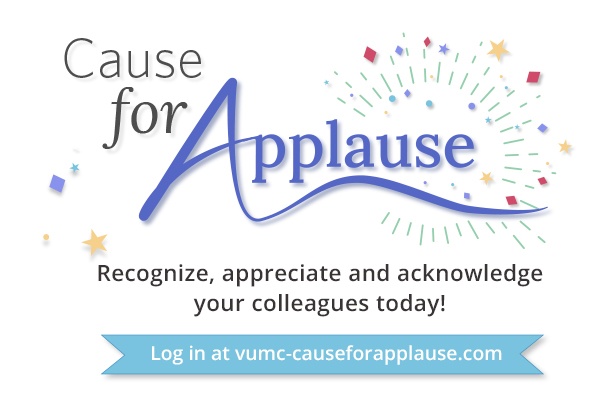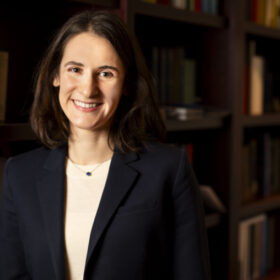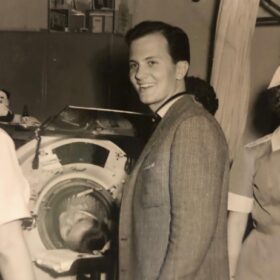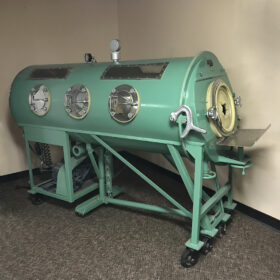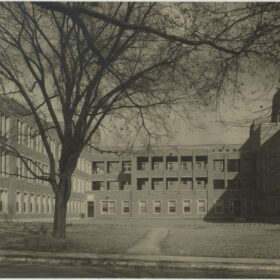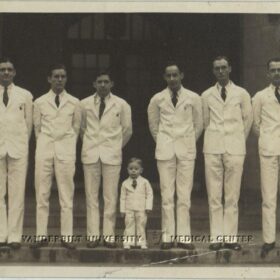An afternoon with the woman who grew up at One Hundred Oaks
It was a retailing wonderland that VUMC transformed into a health care destination. But before all that, it was Carolyn Suschnick's home.
May 12, 2022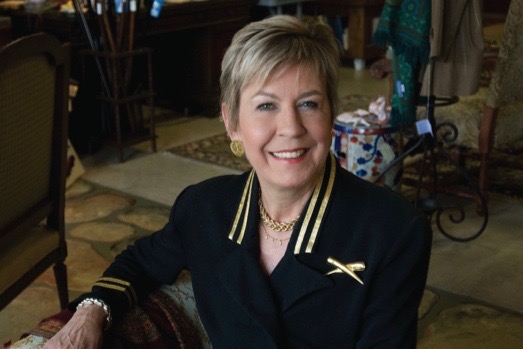
Carolyn Suschnick on the afternoon we spoke in 2008. File photo by Dana Johnson
When it was announced that VUMC has taken steps to lease the Global Mall at the Crossings in Antioch, which most of us still remember by its previous name, Hickory Hollow Mall, I was reminded of the last time VUMC set out to transform a moribund mall into a vibrant health care space.
In February 2008, the first VUMC clinical area, Pediatric Rehabilitation, opened at the former One Hundred Oaks Mall.
The VUMC employees who work at VUMC’s One Hundred Oaks campus come to their workplace with different memories, depending on their age and if they grew up in Nashville.
The original One Hundred Oaks was not a mall, but a house: a two-story log house that was a hub of Nashville entertaining in the 1940s and ‘50s
Some younger people or recent arrivals know only the OHO that is filled with VUMC clinics and patient waiting areas.
Others may be longer-term Nashvillians who remember it when it was a mall, filled with stores and shoppers.
But Carolyn Suschnick had all of us beat – she knew One Hundred Oaks before it was a mall, before it was the location of a movie theater, before – well, before it was anything we recognize today. For the first 12 years of her life, One Hundred Oaks was her girlhood home.
98 Oaks Plus Two Acorns
Suschnick died in 2013, but in 2008, the same year Vanderbilt was setting about to transform the mall, I was able to spend some time talking with her about what she remembered about growing up there.
She had suggested we meet at her business, Westbury House, an antique shop in Columbia, Tennessee, and when we sat down to talk, she pulled out a scrapbook of photographs and newspaper clippings.
As she flipped the pages, the memories came.
The original One Hundred Oaks was not a mall, but a house: a two-story log house that was a hub of Nashville entertaining in the 1940s and ‘50s, and Suschnick’s face brightened as she recalled what it looked like then.
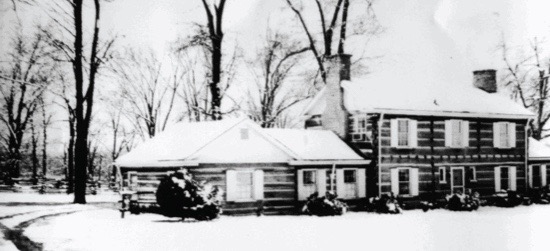
A pastoral winter scene at One Hundred Oaks, the log house that sat on the property that is now the location of One Hundred Oaks mall.
She remembered a stone wall along the front of the land, facing Thompson Lane. There were split rail fences down the side of the property. Orange day lilies brightened up the side yard, and a grove of dogwoods and redbuds further back on the land brought color every spring.
“It was pastoral,” she said. “We had horses. Cats, dogs, baby chickens, turtles, a parakeet, a rabbit. The rabbit ate all my Barbie-doll clothes.”
In a family story that then became Nashville lore, she told me how the name One Hundred Oaks had come about.
“There were 98 oaks there when my mother bought the property,” she said. I guess that meant her mother had walked the property counting oak trees? In any case, I didn’t press her on the details of what was clearly a good origin story.
“She planted two acorns and named it Hundred Oaks,” Suschnick concluded.
Suschnick’s father, Landon Smartt, came back home from the Pacific theater in World War II and, after working for the state, began a career in real estate. When he married Mrs. Smartt, he moved in at One Hundred Oaks.
Growing up at One Hundred Oaks
Suschnick told me that her mother, Virginia Hughes Smartt ran one of the most successful catering and entertaining businesses in Nashville. Beginning in 1947, Mrs. Smartt catered parties and hosted Nashville’s entertainment and business elite at the elegant two-story log house on Thompson Lane.
On one legendary occasion in 1948, she put on what was surely Nashville’s first authentic Hawaiian luau, overseen by a crew of experts flown in from Hawaii.
On the day when I talked to her, Suschnick pulled out one of her mother’s appointment books and noted a certain date in 1952. Her mother put on a breakfast for 60 people and a wedding luncheon for 12. An additional notation at the top of the page makes mention of an add-on event: Carolyn was born later that day.
By 1965, One Hundred Oaks was an island in the midst of what had become a commercial district, and the family decided to sell the property to mall developers.
Growing up at Hundred Oaks was quite an experience for young Carolyn Smartt. Some of the stories she told were from when she was too young to remember but had obviously been shared so often that they were smooth like stones that have tumbled downstream.
“My first word was ‘ice,’” she said. It was a word she would have heard a lot from the bustling commercial kitchen at the log house. While her mother was working and overseeing the staff that kept the business running, she had told Carolyn that keeping an eye on her as a baby was a communal project.
“They used to put me in a box in the kitchen so the help could watch me while they were cooking,” she said.
It was a desire to have time with her daughter that led Virginia to close her business in 1955, when Carolyn was 3. For the next 10 years, One Hundred Oaks was simply home. Carolyn grew up with her menagerie of pets, exploring the grounds and having elements of a rural childhood within sight of two of the busiest streets in Nashville.
But the area was changing. Their next-door neighbor’s property was sold and a Pepsi bottling plant was built, complete with rumbling delivery trucks streaming in and out all day long. By 1965, One Hundred Oaks was an island in the midst of what had become a commercial district, and the Smartt family decided to sell the property to the mall developers, Belz Investment Company of Memphis.
“I was excited,” Suschnick said. Most of her school friends lived in neighborhoods surrounded by other families with children. She didn’t. Most of her friends could ride their bikes around the neighborhood. She couldn’t.
“I thought it would be great to have a new house in a subdivision. I know now what [my parents] lost when [they] sold that house.”
From a House to a Mall
The name was retained when the house was dismantled, the land cleared, and Nashville’s first mall opened on the site in 1967. One Hundred Oaks Mall was a retailing wonderland at the height of the Space Age.
It had J. C. Penney, Harvey’s department store, Woolco and Woolworth’s. At its groundbreaking, the mayor, the wife of the governor, a U.S. Congressman, and several prominent businessmen all smiled for newspaper photographers as the VIPs turned over shovelfuls of dirt.
On the day the mall opened, the superlatives were like signposts to a retailing wonderland. Almost 19 acres of shopping under one roof! A project cost of more than $15 million! Sixty stores! Parking for 4,000 cars!
The first multiscreen movie theater (two screens under one roof!), the Martin Twin, was located in a separate building at the south end of the mall.

A postcard enticed shoppers to the retail wonderland that was One Hundred Oaks. It also got the year of the mall’s opening wrong.
The newly constructed interstate system made it easier for shoppers from all over Middle Tennessee to stream into Nashville, although, in a quirk that was to haunt the mall for two decades, somehow there was no exit that led to One Hundred Oaks, despite the fact that traffic streaming by on I-65 was clearly visible from its parking lot.
But retailing continued to evolve, as it does, and that was not a good thing for the mall. Several other malls opened in the region, most of them bigger and more fabulous and with better highway access, and began doing to One Hundred Oaks what One Hundred Oaks had earlier done to downtown Nashville—stealing its customers.
As the flow of customers dried up, most of the stores closed, including flagships J.C. Penney and Woolco. Some stores hung on and tried to make a go of it, and some new ones opened, including Burlington Coat Factory and a MegaMarket grocery store on the south end of the property.
In 1996 One Hundred Oaks had a grand re-opening, including a new retailing focus on discount and outlet stores, and, on the site of the demolished MegaMarket, the Hollywood 27 movie theater, which was, and is, the most screens under one roof in the region. The first level retail was remodeled to more closely resemble a traditional strip mall, with big box retailers facing the parking lot.
Those retailers, and the movie theater, generally did well.
The interior mall did not, becoming increasingly empty and kind of creepy as time went on. There are few sights more desolate than an abandoned food court. The blaring canned music echoing down the largely deserted mall didn’t help things seem cheerier, either.
The Vanderbilt Transformation
Meanwhile, VUMC was seeing so much growth in demand for its patient care that it was clear that something had to give. A large, already built space not far from the main campus, with easy access and lots of parking was clearly an attractive option, and in 2007 work began to transform the mall for outpatient care.
With the recent announcement of plans to expand to the Global Mall at the Crossings, those efforts to make VUMC’s care more available in more communities have taken another giant step forward.
It has now been 15 years since VUMC began building its outpost at One Hundred Oaks, and in that time the expansion of the Medical Center away from its main campus has been ongoing, including opening practices and acquiring community hospitals in Middle Tennessee. With the recent announcement of plans to expand to the Global Mall at the Crossings, those efforts to make VUMC’s care more available in more communities have taken another giant step forward.
I think it is a good thing for those of us who are current VUMC employees, whether we work at One Hundred Oaks or at another location, to know the history of the place that is such an important part of the Medical Center.
As I said earlier, Carolyn Suschnick died in 2013, but she made it clear when we spoke in 2008 that she was very pleased that Vanderbilt was creating a second Medical Center campus on her family’s old homeplace and once again, bringing the bustle of life into One Hundred Oaks Mall.
“I think it’s fabulous,” she said. “I was born at the old Vanderbilt Hospital,” she said. “It feels like full circle.”




